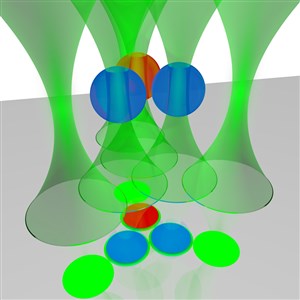 A team of researchers led by Asst. Prof. Giovanni Volpe (Soft Matter Lab, Department of Physics and UNAM) has published an important study in the open-access journal Nature Communications (April 21, 2016). In the study, coauthored by Prof. Andrea Gambassi of the International School for Advanced Study (SISSA) in Trieste, Italy, the investigators measured the presence of many-body effects for critical Casimir forces, i.e., forces acting on microscopic particles immersed in a fluid induced by critical fluctuations.
A team of researchers led by Asst. Prof. Giovanni Volpe (Soft Matter Lab, Department of Physics and UNAM) has published an important study in the open-access journal Nature Communications (April 21, 2016). In the study, coauthored by Prof. Andrea Gambassi of the International School for Advanced Study (SISSA) in Trieste, Italy, the investigators measured the presence of many-body effects for critical Casimir forces, i.e., forces acting on microscopic particles immersed in a fluid induced by critical fluctuations.
The term “many-body effects” refers to the fact that the effect two microparticles have on a third one together might not be the same as the sum of the effects they would have separately. Just as in the macroscopic world, the sum of the parts in the microscopic world is often different from the whole, and interactions can be quite complex.
In the study just published, researchers for the first time measured this effect in a system formed by glass colloids immersed in a critical mixture. By reconstructing the critical Casimir forces when the system was formed by two and then by three colloids, the physicists demonstrated the nonadditivity of these forces. “The knowledge of these effects is very important from the point of view of both fundamental and applied research, especially for the scientists who design micro-machines able to do a variety of tasks,” notes Prof. Gambassi.
In the experiment conducted by Dr. Volpe’s group, the particles were immersed in a mixture of water and lutidine, and two particles confined in place via optical tweezers such that a film of their random motion could be made through the microscope and, via statistical methods, the forces at play accurately inferred. The researchers then added a third particle and compared the results. “In this way,” declared Dr. Volpe, “we demonstrated that the many-body effect is real, and we succeeded in measuring it with an unexpected accuracy: after all, we were dealing with forces that are a thousandth of a millionth of a gram.”
In addition to Dr. Volpe and Prof. Gambassi, the research team included Dr. Sathyanarayana Paladugu, Dr. Agnese Callegari and Lukas Barth of the Soft Matter Lab at Bilkent; Yazgan Tuna of the Soft Matter Lab and UNAM at Bilkent; and Prof. Siegfried Dietrich of the Max-Planck-Institute for Intelligent Systems and the IV. Institute for Theoretical Physics at the University of Stuttgart.
